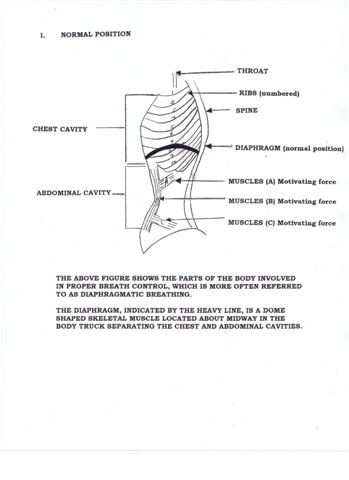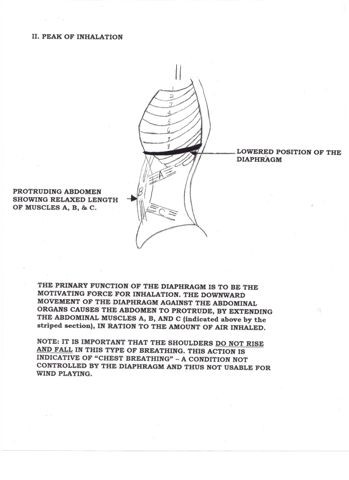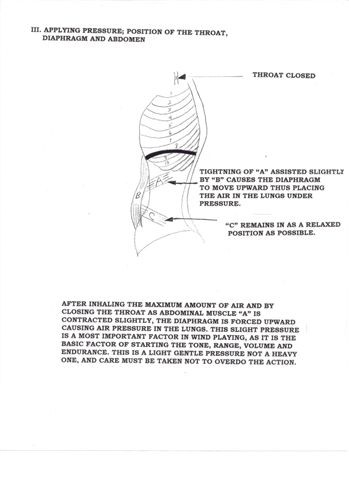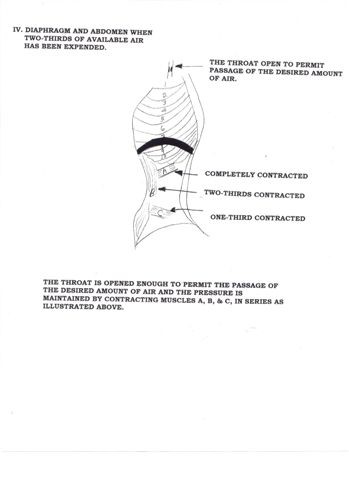
BREATHING
The ability to control the air column pressure is obviously one of the prime requirements of playing a wind instrument, singing or speaking effectively. In all three activities, the process of breathing is basically the same; a short period of inhalation, and a longer period of exhalation when the pressure of the emitted air must be kept under complete control. Good control of exhalation is a very difficult task, if not impossible, unless the diaphragm is used in the breathing process.

CHEST ( THORACIC CAVITY)
The chest or thoracic cavity consists of a framework of bones and cartilage which includes the collar bone, the shoulder blades, the ribs, the sternum and the backbone. The diaphragm is the floor of the thoracic cavity. Above the diaphragm are, among other organs, the lungs and trachea. Below, in the abdominal cavity, are the digestive organs including the stomach, the intestines and the liver.
THE LUNGS
The lungs consist of a mass of tiny air sacs supplied by many air tubes and blood vessels. They play a passive role in respiration. They expand or contract only because of differences in pressure brought about as a result of the activity of the rib and abdominal muscles that expand and contract the thoracic cavity. The lungs having no muscle tissue can neither expand nor contract directly, but rather when air is forced into them as a result of outside pressure, provides increased space for that air. Air is forced out of the lungs when the chest cavity decreases in size and the pressure of the enclosed air is increased.
THE DIAPHRAGM
Although the diaphragm is muscularly active only in the process of inhalation, it nevertheless serves a highly important function in exhalation. It maintains some degree of muscle tension at all times, and in relaxing - as a result of pressure of the abdominal contents upon it - it does so slowly and gradually as the breath is expired. If the diaphragm were to lose all the muscle tone at once, and to relax suddenly and completely, the air from the lungs would be expelled with a sudden rush. Such an expulsion of air would be useless for wind playing. By maintaining some degree of muscle tone, a steady stream of breath is provided thus sustaining complete control of the tone in terms of color, intensity, dynamics and projection.
INSPIRATION
Air enters the lungs by way of mouth or nose, the throat, and the trachea when the volume of the chest cavity is increased. That increase is caused by the downward movement of the diaphragm, by the outward movement of the lower ribs, or by a combination of both activities. In inhalation, the contraction of the diaphragm is an active process; in exhalation, the diaphragm merely relaxes. The diaphragm returns to its former position because of the pressure of the abdominal contents upon it. In controlled muscular activity (forced breathing) necessary for the playing of the clarinet, the muscles of the front and sides of the abdominal wall contract and press inward on the liver, stomach, and intestines. These organs exert an upward pressure on the under surface of the diaphragm which in turn exerts pressure on the lungs and so causes the air to be expelled. Throughout the respiratory cycle, the diaphragm remains roughly dome-shaped, but the height of the dome is greater after the exhalation than inhalation.
CONTROLLED BREATHING
Controlled breathing is best established through voluntary action of the muscles located in the front and sides of the abdominal wall. Observation will reveal that in inhalation the abdominal area moves forward, in exhalation the abdominal area recedes. In terms of muscular activity this means that the abdominal muscles relax in inhalation and contract in exhalation. When the contraction of the abdominal muscles is brought under VOLUNTARY CONTROL, we can, through an act of WILL AND RESPONSIVE ABDOMINAL MUSCLES, determine how long and how much contraction is to take place. BREATHING IS THAN UNDER CONTROL. Such control is useful only for the purposes of blowing into a wind instrument, singing, or for speech. For ordinary purposes, it would be a nuisance to have to think about breathing.




|
|
CAUTION
It often happens that one believes he/she is controlling the muscles of the diaphragm when in fact only tightening the abdominal muscle as though expecting to be struck in that area. To become aware of abdominal activity is the first step. When that activity is correct, further development takes place more or less naturally.